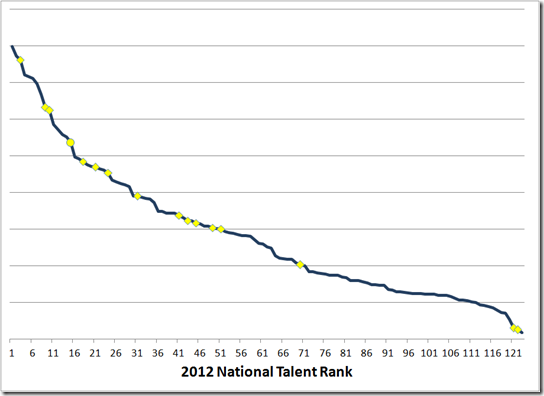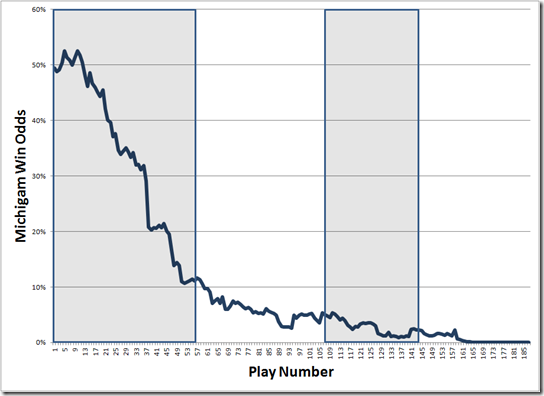The Weekly Maths: Mind The Gap
Over the course of the season there are three key factors that drive the success or failure of a football team:
Talent
Coaching/Execution
Coaching/System
On a game by game basis you can throw in variance/strategy/luck. It’s pretty tough for a high variance strategy to pay out over the long term but for a particular game playing high variance could be the right decision. Teams like Boise State have found success mostly on execution. Oregon and other non-traditional powers have used offensive systems to drive success. The ones who have done it with talent are easy to spot because that’s where the big-time programs all start.
It would have been unrealistic for Michigan to expect Saturday to be a victory on execution over a Nick Saban coached team. Al Borges was apparently comfortable not pushing any system/variance strategies with his choice of play calling (unless you consider the deep balls his way of playing high variance). That left the major gap between Michigan and Alabama to come down to talent. Michigan and Alabama both have storied histories and bright futures for their football teams, but their current rosters are at very different points.
Here is a look at how Michigan’s roster stacks up to the Big Ten and its non-conference opponents. Methodology here

Team |
Points |
Team |
Points |
| Alabama | 3,806 | Illinois | 1,687 |
| Ohio St | 3,161 | Iowa | 1,616 |
| Notre Dame | 3,120 | Northwestern | 1,580 |
| Michigan | 2,684 | Minnesota | 1,517 |
| Nebraska | 2,423 | Purdue | 1,501 |
| Michigan St | 2,345 | Indiana | 1,013 |
| Penn St | 2,267 | Air Force | 126 |
| Wisconsin | 1,949 | UMass | 98 |
Michigan certainly has an enviable roster for most of the country, but attrition and recruiting gaps have left the upper-classes of the roster well below the nation’s elite programs. In fact, the gap between Michigan and Alabama is essentially the same as between Michigan and Minnesota. With Michigan not willing (system/variance) or able (execution) to push the other levers, the talent lever came through in full force.
The good news is that there isn’t a team left on the schedule that can do that to Michigan on talent alone. Holding serve on talent puts Michigan at 9-3 and Legends division champs and potentially favored in the B1G Title Game. The talent gap can give and it can take away. Obviously talent is never a guarantee (ask Texas) but with good coaching, Michigan’s talent should put them in a position to be a competitive or win every game remaining on the schedule. The defense seems positioned to possibly pick up some advantage from coaching, and until the full tenants of the passing attack are in place, the offense will likely be middle of the course to slightly above, depending on how the Denard is deployed.
Barring major attrition issues, Michigan will start to move up the talent list over the next several years. I project them to reach current Ohio/ND range in time for the 2014 and potentially hitting the upper echelons when the current freshman enter their senior season. Until that happens, Michigan will either need to be content to see results like they did on Saturday or find different ways to gain advantages over the next two seasons.
Weekly Notes
Game Chart
Move along, nothing to see here folks.

Game scores (1st half only)
Denard Robinson: 18 plays, -1.2 EV (points added), -8% WPA (win pct added)
Thomas Rawls: 4 plays, -0.3, -1%
Vincent Smith: 9 plays, -2.0, -1.5%
AJ McCarron: 16 plays, +6.7, +12%
Eddie Lacy: 8 plays, +3.4, +4%
TJ Yeldon: 5 plays, +4.4, +7%
Air Force isn’t charted from its week 1 win against an FCS team, but it plenty efficient, scoring TD’s on 4 of 6 first half drives, with one killed by a 15 yard penalty. The defense pitched a first half shutout but did allow 3 of 5 drives into Falcon territory. My preseason rankings installed Michigan as a nearly three touchdown favorite and I have no reason to think expectations have changed substantially.
Michigan 31 Air Force 10, 98% chance of victory
September 6th, 2012 at 7:01 AM ^
Nice post as always - thanks!
There seem to be extra points on the first graph (e.g., at x=70, y=~1000); which teams are those?
September 6th, 2012 at 10:27 AM ^
The point you are referring to is Indiana (I think). UM is included on the graph as the circle (I think) while UM's opponent's are represented by diamonds (I think).
September 6th, 2012 at 10:43 AM ^
yup I think the table was amended post my comment. now I just look like a doofus who can't read graphs :)
(or maybe I am a doofus)
in either case, I love these numbers. One day the mathlete should write a book. "The Calculus of Football" or something like that.
September 6th, 2012 at 7:21 AM ^
September 6th, 2012 at 7:34 AM ^
Completely left off the B1G's Indiana representation on the table. Has now been updated.
September 6th, 2012 at 11:33 AM ^
September 6th, 2012 at 8:05 AM ^
September 6th, 2012 at 12:09 PM ^
I suppose we could have gone for it on fourth down more often. We did have one fourth down attempt (the play where there was the bad snap and Denard got injured); we had two first-half interceptions or maybe there would have been more.
September 6th, 2012 at 12:26 PM ^
I too am completely lost on what counts as 'high variance.'
If throwing deep balls is only sort of high variance then I am totally baffled by this concept.
September 6th, 2012 at 11:34 AM ^
Hold me, The Mathlete.
September 6th, 2012 at 11:38 AM ^
I will never forget the three glorious minutes during which our chances of winning the game were greater than 50%.
September 6th, 2012 at 11:57 AM ^
and forced that 3 and out, I was so excited. Then my buzz wore off.
September 6th, 2012 at 12:11 PM ^
Michigan got a first down after stopping 'Bama. It was a glorious few minutes.
September 6th, 2012 at 11:58 AM ^
I hope everyone realizes the gameplan vs. ND will be very similar to the Alabama game. Their Front 7 isn't isn't as good as Alabama's, but it's damn good. Throwing and not getting Denard killed will again be a priority. And their DBs are probably terrible.
Of course we'll have Fitz for this one
September 6th, 2012 at 12:05 PM ^
Notre Dame has something that Alabama doesn't -

/sinister laugh
September 6th, 2012 at 12:10 PM ^
What is the first chart actually about? What is the Y axis? What are the diamonds?
September 6th, 2012 at 12:42 PM ^
We agree that a high variance strategy was needed against Alabama. . . but I don't know if we saw the same game.
Michigan threw several deep balls, wound up with two TDs and three picks. A couple could've-beens didn't happen, one shouldn't-have-tried was almost intercepted. If that isn't high variance, I don't know what is.
You said, "The talent gap can give and it can take away." Same goes for high variance. ESPECIALLY for high variance. Going deep on Alabama meant Michigan could've won a close game or lost in a blowout. Well, Borges gambled and lost. If the picks wound up being long TDs, guess what the final score would've been?
28-27, Michigan.
I don't like a few things Borges did, but I think he understood what he needed to do just fine.
September 6th, 2012 at 12:53 PM ^
If the picks wound up being long TDs, guess what the final score would've been?
28-27, Michigan.
In a vacuum with only those variables changed, sure. But the score being different at those points changes more variables that would also need to be calculated. Play calling and clock management would certainly have changed if you alter the interceptions.
September 6th, 2012 at 1:15 PM ^
Throwing lots of long passes strikes me as "high variance". Maybe we need a definition of terms.
September 6th, 2012 at 2:28 PM ^
Love this feature. Will look forward to it each week. Keep up the great work.
September 6th, 2012 at 7:42 PM ^
Excellent work, as always, Mathlete.
Just wondering: Have you ever looked to see if your Talent Rank metric has any predictive power as far as wins and losses? For example, can I take two teams, pull their respecitve Talent Rank values, and compute an expected point differential between the two on a neutral field, or better yet, an expected win probability based on talent difference?
It would be interesting to see if Talent Rank predicts wins and losses, and if so, whether Talent Rank has a linear relationship with win probability or not. Without knowing this, it is hard to get a sense for whether Alabama has an equal chance of beating Michigan as Michigan has of beating Minnesota. You make this comparison in your diary, but unless I assume a linear relationship between Talent Rank and win probability, I can't say how Michigan's chances of beating Minnesota compare to Alabama's chances of beating Michigan.
Either way, I think I speak for nerds everywhere when I say this is very interesting stuff.
September 6th, 2012 at 9:59 PM ^
How does JuCo figure in on the team rank? Also what do you do for walk ons that are not given stars before?
Really interesting stuff!!!
September 7th, 2012 at 8:00 AM ^
Players are rated based on their most recent evaluation. If a player was a 5 star out of HS and then 4 star out of JC, the 4 star is the one used for that service. If the service doesn't rate them for JC then the HS is used.
The talent rank is a baseline rating using only data before entering school. I have lots of ways to look at players once they arrive, but this is measuring just prior evaluations. Since no adjustments are made to talent rank based on post-arrival performance, the Jordan Kovacs' of the world are still non-counters in this measurement.
September 7th, 2012 at 7:21 PM ^
Really interesting. I am curious where UM falls relative the SEC. I would put them as 3rd or 4th in the SEC but that is just a guess based on watching the recent game.
September 7th, 2012 at 7:35 PM ^
Really interesting. I am curious where UM falls relative the SEC. I would put them as 3rd or 4th in the SEC but that is just a guess based on watching the recent game.
Comments